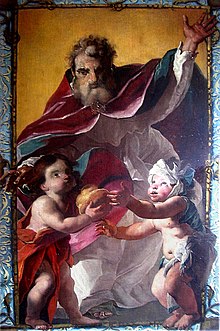Paolo Pagani
Paolo Pagani , also Paolo Antonio Pagani or Paolo Pagano , (born September 22, 1655 in Castello (Valsolda) , † May 5, 1716 in Milan ) was a Baroque painter who worked in Milan and Venice . Pagani painted history pictures , allegories , large-format altar pictures and frescoes .
biography
Pagani was born in Castello Valsolda, the son of Angelo Antonio Pagani and Maddalena Paracca. There are hardly any documents about his early years and his education. Between 1667 and 1668 he settled in Venice . Here in 1675 he was commissioned to paint a "Martyrdom of St. Erasmus" for the Palazzo Molin, today in the Galleria nazionale di palazzo Spinola in Genoa . His pupil was the young painter Giovanni Antonio Pellegrini . In 1680 he made a series of etchings based on pictures by the painter and engraver Giuseppe Diamantini (1621–1705).
In 1692, Prince-Bishop Karl von Liechtenstein commissioned him to paint a hall in his residence in Kroměříž in Moravia with frescoes, which were destroyed in a fire in 1752. His frescoes in the church of the Vehlerad monastery in Moravia have also not survived .
Pagani was married and had two sons, both born in Milan, Angelo Antonio (* 1694) and Guglielmo Pietro (* 1697). He died in Milan in 1716 and was buried in the church of Santa Maria del Giardino near La Scala in Milan.
Works
Very few works by Pagani have survived; others could not be ascribed to him without any doubt. Pagani's pictures are characterized by a dynamic conception of the human body, dramatic composition, naturalistically reproduced details and a virtuoso lighting that was trained by Caravaggio .
- Saint Jerome , around 1685/1690, Liechtenstein Museum
- St. Liborius Heals a Sick , 1617, San Marco Church in Milan
- Allegory of the Eucharist , Museo Casa Pagani Castello Valsolda
Muso Casa Pagani
In 2004 a Paolo Pagani Museum was set up in Valsoldi in the former seat of the Pagani family in Valsolda - a baroque palazzo. One focus of the museum is the documentation of the activities of sculptors, painters and architects from Valsolda, who were mainly active throughout Europe in the Baroque and Rococo periods.
literature
- Romano Amerio: Introduzione alla Valsolda . Fondazione Ticino nostro, Lugano 1970.
- Maurizia Vecchi: La Pala di San Liborio di Paolo Pagani ritrovata . In: Arte Veneta , XXVI, 1972, pp. 207-210.
- Silva Burri: L'affresco di Castello Valsolda nella vicenda artistica di Paolo Pagani . In: Arte Veneta , XXXV, 1981, pp. 113-124.
- Victoria Markova: Inediti della pittura veneta nei musei dell'URSS . In: Saggi e memorie di Storia dell'Arte , 13, 1982, pp. 9-31.
- Ugo Ruggeri: Disegni Veneti e Lombardi dal XVI al XVIII secolo. Dalle collezioni del Gabinetto dei Disegni e delle Stampe . Catalogo della mostra, Roma 1989.
- Cristina Geddo: Giuseppe Diamantini e la sua collaborazione with Paolo Pagani . In: Grafica d'arte , VI, 23, 1995, pp. 2-11;
- Cristina Geddo, Ritrovamenti sul marchese Cesare Pagani committente del pittore Paolo Pagani . In: Paragone , XLVI, III, 1-2 (543-545), 1995, pp. 125-155;
- Federica Bianchi (Ed.): Paolo Pagani 1655-1716 . (Catalogo della mostra tenuta a Rancate e Campione d'Italia nel 1998), Electa, Milano 1998, ISBN 88-435-6552-4 .
- Alessandro Morandotti, Paolo Pagani ei Pagani di Castello Valsolda . Collana Artisti dei laghi, Fidia edizioni d'arte, Lugano 2000.
- Alessandro Morandotti, Gabriele Medolago, Antonio Zaccaria: Paolo Pagani (1655-1716) a Cerete. "L'Estasi di Santa Teresa" . Lubrina Editore, Bergamo 2010.
Web links
- (Italian) short biography
- Dipinti di Paolo Pagani (Italian) in provenezia.ch (accessed on: April 1, 2016.)
- La volta di Paolo Pagani (Italian) in sanmartinovalsolda.it (accessed on: April 1, 2016.)
Individual evidence
- ↑ Paolo Pagani (Italian) in treccani.it/enciclopedia (accessed on: April 1, 2016.)
- ↑ Museo Casa Pagani
| personal data | |
|---|---|
| SURNAME | Pagani, Paolo |
| ALTERNATIVE NAMES | Pagani, Paolo Antonio |
| BRIEF DESCRIPTION | Italian painter |
| DATE OF BIRTH | 22nd September 1655 |
| PLACE OF BIRTH | Castello (Valsolda) |
| DATE OF DEATH | May 5, 1716 |
| Place of death | Milan |


